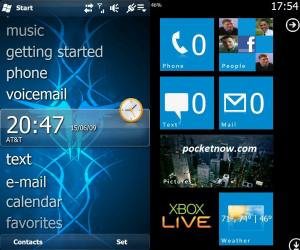What Happened to Windows Mobile? Evolution into Windows Phone 7
 Windows Mobile was always a very popular smartphone operating system, from its beginnings as Pocket PC 2000, back in the year 2000, up until version 6.5 running late into 2009. When it was created, smartphone users were a very select crowd, comprised almost entirely of enterprise users, so it was no surprise that Windows Mobile focused almost entirely on enterprise solutions. It wasn’t until smartphones started becoming popular amongst general users (coinciding with the success of the Apple iPhone) that Windows Mobile started losing ground. Over the last few years of its life, Windows Mobile lost a hefty portion of its market share, leading to a complete system overhaul and introduction of Windows Phone 7.
Windows Mobile was always a very popular smartphone operating system, from its beginnings as Pocket PC 2000, back in the year 2000, up until version 6.5 running late into 2009. When it was created, smartphone users were a very select crowd, comprised almost entirely of enterprise users, so it was no surprise that Windows Mobile focused almost entirely on enterprise solutions. It wasn’t until smartphones started becoming popular amongst general users (coinciding with the success of the Apple iPhone) that Windows Mobile started losing ground. Over the last few years of its life, Windows Mobile lost a hefty portion of its market share, leading to a complete system overhaul and introduction of Windows Phone 7.
The Need for Change
While Windows Mobile offered a lot of pure functionality, it was very rough and unappealing to the general user. It lacked integrated social features, such as Facebook or Twitter; it didn’t have a quick, streamlined interface; and perhaps most importantly, it didn’t include the app-centric experience that people have begun associating with smartphones. Microsoft knew it was time for a change, and thus Windows Phone 7 was born.
Windows Phone 7 (amicably referred to as WP7) took the typical “Windows Look” associated with Windows Mobile and tossed it aside, creating the new “Metro” UI, which features widget-like panels for launching services and providing on-the-spot information, all wrapped up in a sleek, smooth experience.
 Microsoft has also switched to an App-Driven ecosystem with WP7, much like the model used for Apple’s iOS and Google’s Android. Independent third-party developers can create apps for WP7 to be hosted on the Windows Phone Marketplace for end users to purchase and download; however, at just over 27,000 apps, the Windows Phone Marketplace can’t quite compare to either Android’s approximate 420,000 or iOS’s half-million.
Microsoft has also switched to an App-Driven ecosystem with WP7, much like the model used for Apple’s iOS and Google’s Android. Independent third-party developers can create apps for WP7 to be hosted on the Windows Phone Marketplace for end users to purchase and download; however, at just over 27,000 apps, the Windows Phone Marketplace can’t quite compare to either Android’s approximate 420,000 or iOS’s half-million.
What Sets WP7 Apart from the Crowd
With Android and Apple heavily dominating the smartphone market, WP7 has a very steep climb ahead of it, but it still has some redeeming qualities giving it a fair chance. Both Android and iOS take extreme sides with their development model. Android tries to keep a completely “open platform,” allowing anyone to develop and create an Android device. Apple, on the other hand, holds a firmly clenched fist of proprietary reign as the sole manufacturer of iOS devices.
WP7 comes in the middle, using proprietary and uncustomizable software (ala Apple’s iOS) and licensing it to a multitude of manufacturers to create new devices (ala Android). The approach will allow for a secure operating system with uniform and timely updates (something Android has trouble with) while keeping devices fresh and competitive (something Apple is currently struggling with).
 In the end, WP7 is yet another player volleying for a share in the general user smartphone market, but unlike its competitors, it comes from enterprise based roots, which some argue hurts general appeal, but bolsters professional functionality. The HTC HD7 and Samsung Omnia 7 are both already off to a fairly strong start, and top smartphone manufacturer Nokia should be entering the mix soon.
In the end, WP7 is yet another player volleying for a share in the general user smartphone market, but unlike its competitors, it comes from enterprise based roots, which some argue hurts general appeal, but bolsters professional functionality. The HTC HD7 and Samsung Omnia 7 are both already off to a fairly strong start, and top smartphone manufacturer Nokia should be entering the mix soon.


